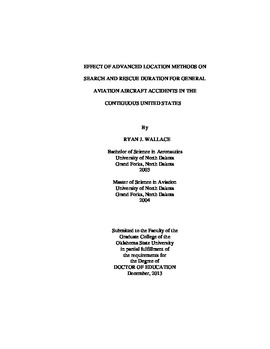| dc.contributor.advisor | Hubbard, Todd | |
| dc.contributor.author | Wallace, Ryan J. | |
| dc.date.accessioned | 2015-06-17T20:08:25Z | |
| dc.date.available | 2015-06-17T20:08:25Z | |
| dc.date.issued | 2013-12 | |
| dc.identifier.uri | https://hdl.handle.net/11244/15168 | |
| dc.description.abstract | The purpose of this study was to determine the impact of advanced search and rescue devices and techniques on search duration for general aviation aircraft crashes. The study assessed three categories of emergency locator transmitters, including 121.5 MHz, 406 MHz, and GPS-Assisted 406 MHz devices. The impact of the COSPAS-SARSAT organization ceasing satellite monitoring for 121.5 MHz ELTs in 2009 was factored into the study. Additionally, the effect of using radar forensic analysis and cellular phone forensic search methods were also assessed. The study's data was derived from an Air Force Rescue Coordination Center database and included 365 historical general aviation search and rescue missions conducted between 2006 and 2011. Highly skewed data was transformed to meet normality requirements for parametric testing. The significance of each ELT model was assessed using a combination of Brown-Forsythe Means Testing or Orthogonal Contrast Testing. ANOVA and Brown-Forsythe Means testing was used to evaluate cellular phone and radar forensic search methods. A Spearman's Rho test was used to determine if the use of multiple search methods produced an additive effect in search efficiency. | |
| dc.description.abstract | Aircraft which utilized an Emergency Locator Transmitter resulted in a shorter search duration than those which did not use such devices. Aircraft utilizing GPS-Aided 406 MHz ELTs appeared to require less time to locate than if equipped with other ELT models, however, this assessment requires further study due to limited data. Aircraft equipped with 406 MHz ELTs required slightly less time to locate than aircraft equipped with older 121.5 MHz ELTs. The study found no substantial difference in the search durations for 121.5 MHz ELTs monitored by COSPAS-SARSAT verses those which were not. Significance testing revealed that the use of cellular phone forensic data and radar forensic data both resulted in substantially higher mission search durations. Some possible explanations for this finding are that these forensic methods are not employed early in search missions or were delayed until more conventional search means are exhausted. The study also found a positive correlation between the number search contributors used and mission duration, indicating that multiple search methods do not necessarily yield added efficiency. | |
| dc.format | application/pdf | |
| dc.language | en_US | |
| dc.rights | Copyright is held by the author who has granted the Oklahoma State University Library the non-exclusive right to share this material in its institutional repository. Contact Digital Library Services at lib-dls@okstate.edu or 405-744-9161 for the permission policy on the use, reproduction or distribution of this material. | |
| dc.title | Effect of advanced location methods on search and rescue duration for general aviation aircraft accidents in the contiguous United States | |
| dc.contributor.committeeMember | Bliss, Timm | |
| dc.contributor.committeeMember | Marks, Steven | |
| dc.contributor.committeeMember | Depperschmidt, Chad | |
| dc.contributor.committeeMember | Key, James | |
| osu.filename | Wallace_okstate_0664D_13027.pdf | |
| osu.accesstype | Open Access | |
| dc.type.genre | Dissertation | |
| dc.type.material | Text | |
| dc.subject.keywords | 121.5 mhz | |
| dc.subject.keywords | 406 mhz | |
| dc.subject.keywords | cellular phone forensics | |
| dc.subject.keywords | cospas-sarsat | |
| dc.subject.keywords | emergency locator transmitter | |
| dc.subject.keywords | search and rescue | |
| thesis.degree.discipline | Applied Educational Studies | |
| thesis.degree.grantor | Oklahoma State University | |
